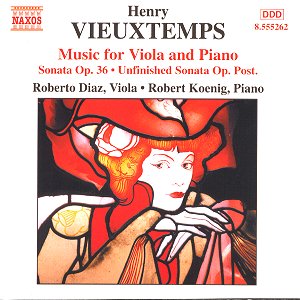One of the leaders of the emergent and dominant Franco-Belgian school Vieuxtemps’ reputation rests on a sheaf of virtuoso violin masterpieces. But he did write for other instruments, for cello, for instance as well as for viola, at which he was adept. Diaz and Koenig give us an entertaining hour’s worth of Vieuxtemps the Violist, adding to the relatively well-known Op 36 Sonata other morceaux and genre pieces of lyrical persuasiveness if not transcendent compositional genius and appending a most interesting disinterment – two movements of a putative incomplete Sonata. The B Flat Major Sonata dates from the early 1860s – it was first published in Leipzig in 1863 – and what is immediately apparent is the cellistic sonority Diaz exploits in viola writing that deliberately ranges from depths to heights of compass. The increasingly lyrical impress of the music is accompanied by concomitant technical demands, met with panache by the soloist, and almost devouringly exploitative of registral change (an overindulged one it’s true). Diaz emphasises the sometimes rather hoarse middle voicings Vieuxtemps encourages and really makes something of the theatrically withdrawn passage before he makes a superb crescendo to the apex of the movement. A Barcarolle ripples through the second movement in which registral conjunction is again a rather over-nuanced feature; there’s a quasi-operatic or vocal element to the writing here and in the rip-roaring finale some roistering playing, well-balanced in the dramatic passagework laden conclusion.
The Elegie is scored for viola or cello and dates from 1854. It is appropriately songful and decorative, with strong double-stopping, some excellently propulsive left hand work from Koenig. The Capriccio was new to me: an unaccompanied work of six that form a set, issued posthumously between 1881 and1887, originally written for violin. Expressive and demanding it is a brief three-minute piece of decidedly impressive cast. The Felicien David transcription is derived from his ode-symphonie Le desert of 1854. As for the Unfinished Sonata it’s not at all certain that this was in fact intended as such; it’s equally possible that the two movements had a projected independent life. Nevertheless they have been so presented in this Naxos disc. They are two substantial movements totally twenty-five minutes in length - the Allegro con fuoco has all the expected Vieuxtemps trademarks of lyricism, passion, technical demands whilst the Scherzo is a trio-laden affair, quixotic and rhythmically energised. These are excellent performances, as I hope I’ve made clear, and attractive works. Competition does exist. Imai and Vignoles have recorded the Sonata (Chandos CHAN8873) and in the case of the delightful Elegie you can also sample Imai and Vignoles again on that same Chandos disc or the formidable pairing of Kim Kashkaskian and Robert Levin on ECM.
Jonathan Woolf


